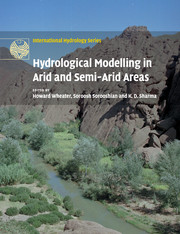Book contents
- Frontmatter
- Contents
- List of contributors
- Preface
- Acknowledgements
- 1 Modelling hydrological processes in arid and semi-arid areas: an introduction
- 2 Global precipitation estimation from satellite imagery using artificial neural networks
- 3 Modelling semi-arid and arid hydrology and water resources: The southern Africa experience
- 4 Use of the IHACRES rainfall-runoff model in arid and semi-arid regions
- 5 KINEROS2 and the AGWA modelling Framework
- 6 Ephemeral flow and sediment delivery modelling in the Indian arid zone
- 7 The modular modelling system (MMS): a toolbox for water and environmental resources management
- 8 Calibration, uncertainty, and regional analysis of conceptual rainfall-runoff models
- 9 Real-time flow forecasting
- 10 Real-time flood forecasting: Indian experience
- 11 Groundwater modelling in hard-rock terrain in semi-arid areas: experience from India
- Appendix Access to software and data products
- Index
- Plate section
- References
6 - Ephemeral flow and sediment delivery modelling in the Indian arid zone
Published online by Cambridge University Press: 15 December 2009
- Frontmatter
- Contents
- List of contributors
- Preface
- Acknowledgements
- 1 Modelling hydrological processes in arid and semi-arid areas: an introduction
- 2 Global precipitation estimation from satellite imagery using artificial neural networks
- 3 Modelling semi-arid and arid hydrology and water resources: The southern Africa experience
- 4 Use of the IHACRES rainfall-runoff model in arid and semi-arid regions
- 5 KINEROS2 and the AGWA modelling Framework
- 6 Ephemeral flow and sediment delivery modelling in the Indian arid zone
- 7 The modular modelling system (MMS): a toolbox for water and environmental resources management
- 8 Calibration, uncertainty, and regional analysis of conceptual rainfall-runoff models
- 9 Real-time flow forecasting
- 10 Real-time flood forecasting: Indian experience
- 11 Groundwater modelling in hard-rock terrain in semi-arid areas: experience from India
- Appendix Access to software and data products
- Index
- Plate section
- References
Summary
STUDY AREA: THE LUNI BASIN
The Luni and its tributaries form the only integrated drainage system in north-west arid India. The Luni originates in the Aravalli hill ranges near Ajmer (20.5°N, 74.7°E) and after an initial west-south-westerly course, flows south-west until it discharges into the Rann of Kachchh (Fig. 6.1). The area of the Luni drainage basin is 34866km2 and elevations range from 886m at the source to 10m at the outlet. In the upland region the mean depth, width, and gradient of the flow channels are 1.2m, 158m, and 0.00245, respectively, whereas in the channel phase these are 3.6m, 1958m and 0.0012, respectively. The drainage basin areas vary from 104 to 950km2 in the upland region and 1449 to 5492km2 in the downstream valley. The eastern part of the drainage basin is a hilly and rocky piedmont, underlaid by igneous and metamorphic rocks of Precambrian and Paleozoic age. Of the drainage basin, 52% is rugged mountainous terrain with shallow soils and minor amounts of unconsolidated alluvium. The western part of the drainage basin consists of Pleistocene alluvium and Holocene sand ranging from 1 to 40m in depth.
Annual precipitation in the Luni drainage basin ranges between 600mm in the south-east and 300mm in the north-west. The rainfall season is relatively short, starting in June and ending in September with 80% of rainfall occurring during July and August. The number of rainy days is low (about 14).
- Type
- Chapter
- Information
- Hydrological Modelling in Arid and Semi-Arid Areas , pp. 69 - 86Publisher: Cambridge University PressPrint publication year: 2007



